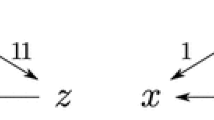Abstract
We introduce the following basic voting method: voters submit both a “consensus” and a “fall-back” ballot. If all “consensus” ballots name the same option, it wins; otherwise, a randomly drawn “fall-back” ballot decides. If there is one potential consensus option that everyone prefers to the benchmark lottery which picks the favorite of a randomly drawn voter, then naming that option on all “consensus” ballots builds a very strong form of correlated equilibrium. Unlike common consensus procedures, ours is not biased toward the status quo and removes incentives to block consensus. Variants of the method allow for large groups, partial consensus, and choosing from several potential consensus options.
Similar content being viewed by others
References
Aumann R (1959) Acceptable points in general cooperative n-person games. In: Tucker A, Luce R (eds) Contributions to the theory of games IV. Princeton University Press, Princeton
Aumann R (1974) Subjectivity and correlation in randomized strategies. J Math Econ 1: 67–96
Bernheim B, Peleg B, Whinston M (1987) Coalition-proof Nash equilibria I: concepts. J Econ Theory 42: 1–12
Bloch F, Dutta Bh (2009) Correlated equilibria, incomplete information and coalitional deviations. Games Econ Behav 66(2): 721–728
Einy E, Peleg B (1995) Coalition-proof communication equilibria. In: Barnett WA (eds) Social choice, welfare, and ethics. Cambridge University Press, Cambridge
Enelow JM, Hinich MJ (1984) The spatial theory of voting: an introduction. Cambridge University Press, Cambridge
Gibbard A (1977) Manipulation of schemes that mix voting with chance. Econometrica 45(3): 665–681
Hansson SO (1996) Social choice with procedural preferences. Soc Choice Welf 13: 215–230
Laffond G, Lainé J, Laslier J-F (1996) Composition-consistent tournament solutions and social choice functions. Soc Choice Welf 13(1): 75–93
Machina M (1987) Choice under uncertainty: problems solved and unsolved. J Econ Perspect 1(1): 121–154
Mandler M (2005) Incomplete preferences and rational intransitivity of choice. Games Econ Behav 50(2): 255–277
Milgrom P, Roberts J (1996) Coalition-proofness and correlation with arbitrary communication possibilities. Games Econ Behav 17: 113–128
Moreno D, Wooders J (1996) Coalition-proof equilibrium. Games Econ Behav 17: 80–112
Moulin H, Vial JP (1978) Strategically zero-sum games: the class of games whose completely mixed equilibria cannot be improved upon. Int J Game Theory 7(3–4): 201–221
Myerson RB (1991) Game theory: analysis of conflict. Harvard University Press, Cambridge
Ray I (1996) Coalition-proof correlated equilibrium: a definition. Games Econ Behav 17(2): 56–79
Ray I (1998) Correlated equilibrium as a stable standard of behavior. Rev Econ Des 3: 257–269
Saint S, Lawson JR (1994) Rules for reaching consensus: a modern approach to decision making. Pfeiffer, San Diego
Tideman N, Tullock G (1976) A new and superior process for making social choices. J Polit Econ 84(6): 1145–1159
Author information
Authors and Affiliations
Corresponding author
Rights and permissions
About this article
Cite this article
Heitzig, J., Simmons, F.W. Some chance for consensus: voting methods for which consensus is an equilibrium. Soc Choice Welf 38, 43–57 (2012). https://doi.org/10.1007/s00355-010-0517-y
Received:
Accepted:
Published:
Issue Date:
DOI: https://doi.org/10.1007/s00355-010-0517-y




